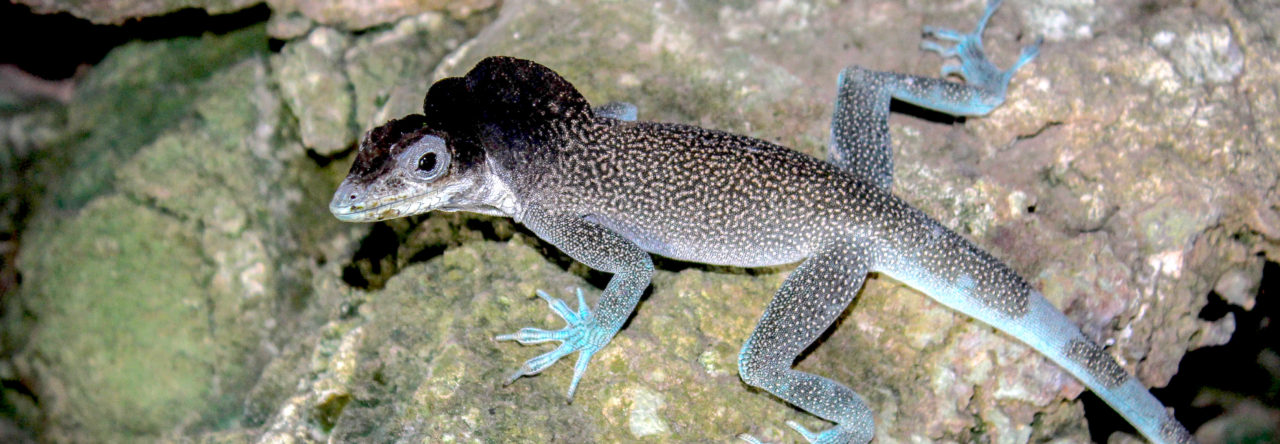
The Joint Meeting of Ichthyologists and Herpetologists (JMIH) kicked off here in New Orleans yesterday. In the morning, Jonathan Losos got started with the first of many anole themed talks. Jonathan gave one the plenary addresses as the Herpetologists’ League’s “Distinguished Herpetologist” of 2016. As such, he joins a long list of accomplished herpetologists, including the first recipient of the honor in 1981, the great anole biologist (and Jonathan’s undergraduate advisor) Ernest E. Williams.
In Jonathan’s talk entitled “Known knowns and unknown unknowns: herpetological progress in fits and starts”, Jonathan started by paying homage to Ernest Williams. He managed to find slides from Ernest’s 1981 plenary address in which the perception at the time of anole biology was compared to a well-built building. All there was to know about anoles was known… or so people thought. In reality, the building looked more like this:

E.E. Williams slide on the state of anole knowledge from 1981
The metaphorical building at the time was in fact only partially built, with bits and pieces of different areas more complete than others. Jonathan’s talk focused on the fact that despite over 3 decades of progress, so much is still unknown about anoles, including basic natural history of many species. And so Jonathan shared with us a few stories highlighting some surprising anole findings and remaining unknowns, featuring the work of his students from the past 20 years:
Genetic diversity:
One surprise finding over the past 30 years is that several anole species have deep  mitochondrial splits. Anolis oculatus, for example, on the tiny island of Dominica has 4 distinct lineages with as great as 10% mtDNA divergence (Malhotra and Thorpe 2000)! And they aren’t the only ones. Rich Glor and Jason Kolbe really broke this story open with their analysis of several anole species showing multiple mitochondrial lineages for each (Kolbe et al. 2007). This brings into question our estimates of diversity. If every species is actually 4+ species, have we underestimated diversity?
mitochondrial splits. Anolis oculatus, for example, on the tiny island of Dominica has 4 distinct lineages with as great as 10% mtDNA divergence (Malhotra and Thorpe 2000)! And they aren’t the only ones. Rich Glor and Jason Kolbe really broke this story open with their analysis of several anole species showing multiple mitochondrial lineages for each (Kolbe et al. 2007). This brings into question our estimates of diversity. If every species is actually 4+ species, have we underestimated diversity?
New Species:
According to Jonathan, it seems that the “dawn of anole discovery” peaked in the 1970’s – the last very distinctly different anole was discovered nearly 40 years ago. And yet just last month, Luke Mahler et al. published a record of a new species of anole discovered on the island of Hispaniola! Hispaniola has been intensely studied by anole biologists, making this all the more surprising. In honor of the naturalist that found the species in the wild, the authors named the new species Anolis landestoyi. This new species has a striking appearance, similar to a chameleon and to the Cuban “false chameleons” (Chamaeleolis clade of anoles), and brings up the question of whether there might be a seventh ecomorph.

Anolis landestoyi, photo by D. Luke Mahler
Territoriality:
Highlighting the work of two other Losos Lab members, Alexis Harrison and Ambika Kamath, Jonathan talked about how little we know abut anole territoriality. Conventional knowledge says that males maintain polygynous territories and don’t move too far. But Ambika has shown in her dissertation work that male Anolis sagrei actually move quite a bit, and Alexis has shown that male Anolis carolinensis mate with females on opposite sides of their site, not just nearby females! In general, Jonathan commented that there is a large amount of work to be done still on social behavior in anoles.

Anolis proboscis (photo by Luke Mahler)
Basic Biology:
Jonathan talked about the Anole Annals darling, Anolis proboscis. This understudied species sports a large nasal projection of unknown purpose. This odd species was thought to be extinct for many years until it was “rediscovered” only a few years ago. While sexual selection seems like an obvious cause of this structure (the females do not possess horns), its not clear what the males use it for. The obvious hypothesis, that it is used for male-male combat, is easily refuted by video demonstrating that this structure bends easily. Moreover, it appears that they can bend the horn, as seen in this video! The mystery of this structure’s function remains unsolved.
Finally, Jonathan talked about an interesting anecdote: that Anolis agassizi from Malpelo island seems to have a strange preference for the color orange, as described by Rand et al. (1975). Jonathan described a recent test of this preference replicating the Chuckles candy experiment (the experiment has been described here on Anole Annals) and confirming that this species does, in fact, prefer the colors orange and yellow when it comes to Chuckles candy. He also showed a video of A. agassizi swooping in from afar to eat (attack?) an orange. Why are they so attracted to this color? Sounds like a project waiting to happen.
In short, Jonathan emphasized these two main points:
1. Natural history information is key; you need to know basic aspects of biology and natural history to dig into the deeper questions.
2. There are so many questions to be answered about anoles still, and room for all who want to join the party.

























